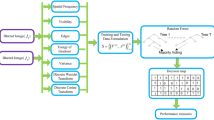Abstract
Due to the limitation of depth of focus, we cannot capture images with all objects in focus. Such images always lose some information, limiting their application. In recent years, with the wide application of dual-camera devices, we can easily acquire multifocus images of the same scene. Image fusion methods can be used to integrate these multifocus images into a fused image, which preserves specific features, and have more information. In this article, we use the patches instead of the pixels as the processing unit and process each patch in the spatial domain. In addition, diverse features of patches are fed into random forest to obtain fidelity scores, which used to measure the clarity of patches. Finally, hidden Markov model is used to consider compatibility between adjacent patches. From the perspective of visual effects and quantitative evaluations, the proposed method has better results than many previous fusion methods.










Similar content being viewed by others
References
Balasubramaniam P, Ananthi VP (2014) Image fusion using intuitionistic fuzzy sets. Inf Fusion 20(1):21–30
Breiman L (2001) Random forest. Mach Learn 45:5–32
Burt PJ, Adelson EH (1987) The Laplacian pyramid as a compact image code. Read Comput Vis 31(4):671–679
Cunha ALD, Zhou J, Do MN (2006) The nonsubsampled contourlet transform: theory, design, and applications. IEEE Trans Image Process Publ IEEE Signal Process Soc 15(10):3089–3101
De I, Chanda B (2006) A simple and efficient algorithm for multifocus image fusion using morphological wavelets. Signal Process 86(5):924–936
De I, Chanda B (2013) Multi-focus image fusion using a morphology-based focus measure in a quad-tree structure. Inf Fusion 14(2):136–146
Du C, Gao S (2017) Image segmentation-based multi-focus image fusion through multiscale convolutional neural network. IEEE Access 5:15750–15761
Eltoukhy HA, Kavusi S (2003) A computationally efficient algorithm for multi-focus image reconstruction. Proc SPIE-Int Soc Opt Eng 5017:332–341
Image set. http://www.image-net.org/. Accessed April 1 2018
Jin X, Zhou D, Yao S, Nie R, Jiang Q, He K, Wang Q (2018) Multi-focus image fusion method using S-PCNN optimized by particle swarm optimization. Soft Comput 22(19):6395–6407
Lewis JJ, O’Callaghan RJ, Nikolov SG, Bull DR, Canagarajah N (2007) Pixel- and region-based image fusion with complex wavelets. Inf Fusion 8(2):119–130
Li S, Kwok JT, Wang Y (2001) Combination of images with diverse focuses using the spatial frequency. Inf Fusion 2(3):169–176
Li S, Kwok JT, Wang Y (2002) Multifocus image fusion using artificial neural networks. Pattern Recognit Lett 23:985–997
Li S, Kwok JT, Tsang IW, Wang Y (2004) Fusing images with multiple focuses using support vector machines. IEEE Trans Neural Netw 15:1555–61
Li J, Li X, Yang B, Sun X (2017) Segmentation-based image copy-move forgery detection scheme. IEEE Trans Inf Forensics Secur 10(3):507–518
Liu Y, Chen X, Peng H, Wang Z (2017) Multi-focus image fusion with a deep convolutional neural network. Inf Fusion 36:191–207
Madhavi R, Babu PKA (2011) An all approach for multi-focus image fusion using neural network. Int J Comput Sci Telecommun 2:23–29
Mamatha SG, Rahim SA, Raj CP (2012) Feature-level multi-focus image fusion using neural network and image enhancement. Glob J Comput Sci Technol Graph Vis 12:16–23
Naidu V, Raol JR (2008) Pixel-level image fusion using wavelets and principal component analysis. Def Sci J 58(3):338–352
Qilei Li, Yang Xiaomin Wu, Wei Liu Kai, Jeon Gwanggil (2018) Multi-focus image fusion method for vision sensor systems via dictionary learning with guided filter. Sensors 18:2143–2155
Qu G, Zhang D, Yan P (2002) Information measure for performance of image fusion. Electron Lett 38(7):313–315
Schwarz, Wien (2008) Signal and image processing with belief propagation. Signal Process Mag IEEE 25(2):114–141
Tian L, Wang H, Zhou Y, Peng C (2018) Video big data in smart city: background construction and optimization for surveillance video processing. Futur Gener Comput Syst 86:1371–1382
Tian L, Li J, Zhou Y, Wang H (2018) Picture quality assessment based rate control for variable bandwidth network. Tsinghua Sci Technol 18:18–28
Wu W, Liu Z, Gueaieb W, He X (2011) Single-image super-resolution based on Markov random field and contourlet transform. J Electron Imaging 20(2):1–18
Wu W, Yang X, Pang Y, Peng J, Jeon G (2013) A multifocus image fusion method by using hidden Markov model. Opt Commun 287(1):63–72
Xydeas CS, Petrovic VS (2000) Objective pixel-level image fusion performance measure. Int Soc Opt Eng 4051:89–98
Zhang Q, Guo BL (2009) Multifocus image fusion using the nonsubsampled contourlet transform. Signal Process 89(7):1334–1346
Funding
This research is supported by the National Natural Science Foundation of China (No. 61701327, No. 61711540303, and No. 61473198), National Research Foundation of Korea (No. NRF-2017K2A9A2A06013711), Priority Academic Program Development of Jiangsu Higher Education Institutions (PAPD) Fund. This work is also supported under the framework of international cooperation program managed by the National Research Foundation of Korea(NRF-2017K2A9A2A06013711).
Author information
Authors and Affiliations
Corresponding authors
Ethics declarations
Conflict of interest
All the authors declare that no conflict of interest exits in the submission of this manuscript, and manuscript is approved by all authors for publication.
Ethical approval
This article does not contain any studies with animals performed by any of the author.
Additional information
Communicated by A. K. Sangaiah, H. Pham, M.-Y. Chen, H. Lu, F. Mercaldo.
Publisher's Note
Springer Nature remains neutral with regard to jurisdictional claims in published maps and institutional affiliations.
Rights and permissions
About this article
Cite this article
Wu, S., Wu, W., Yang, X. et al. Multifocus image fusion using random forest and hidden Markov model. Soft Comput 23, 9385–9396 (2019). https://doi.org/10.1007/s00500-019-03893-9
Published:
Issue Date:
DOI: https://doi.org/10.1007/s00500-019-03893-9




